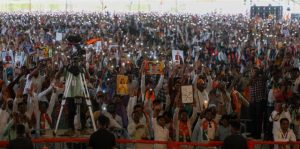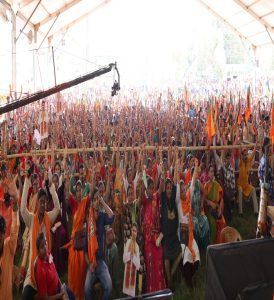Roadmap for increasing income of small farmers in India

By Pradeep Kumar Panda
Bhubaneswar, May 27: Agriculture is the backbone of Indian economy. Although its contribution to gross domestic product (GDP) is now around one sixth, it provides employment to 56 per cent of the workforce. Also, the forward and backward linkage effects of agriculture growth increase the incomes in the non-agriculture sector. However, there have been exclusion problems like problems of poverty, unemployment, inequalities in access to health and education and poor performance. Real development in terms of growth shared by all sections of the population has not taken place. One of the excluded sector during the reform period was agriculture which showed low growth and experienced more farmers’ distress.
There are serious concerns on the performance of agriculture sector in the country and need attention of policy makers. Small holdings agriculture is important for raising agriculture growth, food security and livelihoods in India. Indian agriculture is the home of 80 per cent small and marginal farmers. Therefore, the future of sustainable agriculture growth and food security in India depends on the performance of small and marginal farmers.
The number of smallholdings has been consistently increasing in India since the first Agriculture Census in 1970-71. The number of holdings, which was 71 million in 1970-71 went upto 138.35 million in 2010-11showing a compound annual growth rate of 1.68 per cent during the period (Agriculture Census, 2011).
However, the operated area which was 162.3 million hectares in 1970-71 marginally declined to 159.59 million hectares in 2010-11. The average size of holdings had shown a consistent decline over all the census periods. For instance, in 1970-71 it was 2.28 hectares which was reduced to 1.15 hectares in 2010-11 (Agriculture Census, 2011).
The access to irrigation has increased for all categories of farmers. It is the highest for marginal farmers followed by small farmers. Data indicate that the percentage of area under irrigation for small farmers increased from 40 in 1980-81 to 51 in 2000-01. (NCEUS, 2008).
The fertilizer per hectare is inversely related to farm size for both irrigated and unirrigated areas. It increased from marginal farmers in irrigated areas from 100 kgs. in 1980-81 to 252 kgs. in 2001-02. In fact, the per hectare consumption for all farm sizes was similar on irrigated areas in 1981-82 but it rose faster for marginal farmers and small farmers in 2001-02. This is true in the case of unirrigated areas also. (Dev, 2012).
The percentage of area under high yielding varieties (HYV) is also inversely related to farm size. In the irrigated areas, the coverage of are under HYV was 89 per cent, 86 per cent and 78 per cent respectively in marginal, small and large farmers in 2001-02. In the case of unirrigated areas, the coverage was above 50 per cent for marginal, small and semi-medium but it was only 30 per cent for large farmers in 2001-02. (Rao, 2011).
Multiple cropping index is higher for marginal and small farmers than that for medium and large farmers. For marginal farmers, cropping intensity increased from 134 in 1981-82 to 139 in 2001-02. In the case of large farmer, it rose from 116 to 121 during the same period. The differences across farm sizes persisted over time. (Gulati, 2009).
The contribution to output is higher for marginal and small farmers as compared to their share in area. The share of these farmers was 46.1 per cent in land possessed but they contribute 51.2 per cent to the total output of the country at all India level in 2002-03.(Agriculture Census, 2011).
In terms of production, small and marginal farmers also make larger contribution to the production of high value crops. They contribute around 70 per cent to the total production of vegetables, 55 per cent to fruits against their share of 44 per cent in land area (Birthal, 2011).
Their share in cereal production is 52 per cent and 69 per cent in milk production. Thus, small farmers contribute to both diversification and food security. Only in the cases of pulses and oilseeds, their share is lower than other farmers. There has been debate in India on the relationship between farm size and productivity. The results of NSS 2003 Farmers’ survey has empirically established that small farms continue to be produce more in value terms per hectare than the medium and large farms.
Data show that value of output per hectare was Rs.14754 for marginal farmers, Rs.13001 for small farmers, Rs. 10655 for medium farmers and Rs.8783 for large farmers. It shows that from efficiency point of view, small holdings are equal or better than large holdings. (Rao, 2011).
The sustainability of these farmers is crucial for livelihoods in rural areas and for the entire country. The cost of cultivation per hectare is also high on small and marginal farmers than medium and large farms. (Agriculture Census, 2011).
However, the monthly income and consumption figures across different size class of land holdings show that marginal and small farmers have dis-savings compared to medium and large farmers. According to NSS 2003 data, the monthly consumption of marginal farmers was Rs.2482 and monthly income was Rs.1659. It shows that they have dis-savings of Rs.823. The dis-savings for small farmers were Rs.655. On the other hand, for large farmers, monthly income and consumption respectively were Rs.9667 and Rs.6418 with savings of Rs.3249 (Vaidyanathan, 2011).
Issues and Challenges for Smallholder Farmers in India
Imperfect Market: NCEUS (2008) says that some of the general issues that confront marginal-small farmers as agriculturalists are imperfect markets for inputs/product leading to smaller value. According to Gaurav and Mishra (2011), reasons of low income are absence of access to credit markets or imperfect credit markets leading to suboptimal investment decisions or input applications; poor human resource base; smaller access to suitable
extension services restricting suitable decisions regarding cultivation practices and technological know-how; poorer access to ‘public goods’ such as public irrigation, command area development, electricity grids; greater negative externalities from poor quality land and water management, etc.
Role of Women: The importance of women in agriculture has been increasing. The share of rural females in agriculture was around 83 per cent in 2004-05 as compared to 67 per cent among rural men, showing the importance of women in agriculture in rural areas. Percentage of women among marginal farmers (38.7 per cent) is higher than that for large farmers (34.5 per cent) in 2004-05. These proportions have increased over time. Agriculture is becoming increasingly feminized as men are migrating to rural non-farm sector. (Rao, 2007).
Role of Social Groups: The proportion of socially disadvantaged groups such as Scheduled Castes (SCs) and Scheduled Tribes (STs) is higher among marginal and small farmers than that of medium and large farmers. Around 22 per cent of semi-marginal and marginal farmers are from SCs compared to 7.8 per cent in medium and large farmers. SCs have more than half of their holdings of less than half a hectare. Similarly, 15.6 per cent of small farmers belong to STs compared to 14.9 per cent among medium and large farmers. The distribution of land ownership among STs is better than SCs. However, the quality of STs land is probably of the lowest quality. Social identity of farmers is also seen to mediate access to economic resources and outcomes. Even after accounting for quantity and quality of land owned by socially deprived classes, their access to information, marketing, credit and publicly provided inputs and extension services are lower. This shows that they possibly suffer from discrimination in the delivery of public services as well as market (NCEUS, 2008).
Land and tenancy security: NCEUS (2008) argued that there is a strong evidence that relatively successful implementation of even a modest package of land reforms dramatically improve the prospect of the poor. Regarding small and marginal farmers, they own and cultivate some land but it is a limiting factor for getting resources. Therefore, tenancy security is important for small holding farmers. Land relations are extremely complicated and this complexity has contributed significantly to the problems facing actual cultivators.
Unregistered cultivators, tenants, and tribal cultivators all face difficulties in accessing institutional credit and other facilities available to farmers with land titles. On land market, the Report of the Steering Committee recommended the following. “Small farmers should be assisted to buy land through the provision of institutional credit, on a long term basis, at a low rate of interest and by reducing stamp duty. At the same time, they should be enabled to enlarge their operational holdings by liberalizing the land lease market. The two major elements of such a reform are: security of tenure for tenants during the period of contract; and the right of the land owner to resume land after the period of contract is over” (Gulati, 2009).
Low level of formal education and skills: Education and skills are important for improving farming practices, investment and productivity. It shows that literacy and mean years of education are lower for small holding farmers compared to medium and large farmers. For example, literacy among males and females for marginal farmers respectively were 62.5 per cent and 31.2 per cent while the corresponding numbers for medium and large farmers were 72.9 per cent and 39 per cent.
Similarly, mean years of education for males among marginal farmers was 3.9 as compared to 5.3 for medium and large farmers. The low level of farmers’ education limits public dissemination of knowledge. The NSS farmers’ Survey clearly shows that awareness about bio-fertilizers, minimum support prices and WTO is associated with education levels which are lower for marginal and small farmers.
Credit and Indebtedness: Small holdings need credit for both consumption and investment purposes. Increasing indebtedness is one of the reasons for indebtedness among these farmers in recent years. Data show that overall indebtedness is not higher for small and marginal farmers compared to large farmers. However, the indebtedness for the small and marginal farmers from formal institutional sources is lower than large farmers and the reverse is true in the case of informal sources. The dependence on money lenders is the highest for sub-marginal and marginal farmers.
Water Scarcity: Water is the leading input in agriculture. Development of irrigation and water management are crucial for raising levels of living in rural areas. Agriculture has to compete for water with urbanization, drinking water and industrialization. As mentioned above, small holding agriculture depend more on ground water compared to large farmers who has more access on canal water. Ground water is depleting in many areas of India. Marginal and small farmers are going to face more problems regarding water in future.
Risk and vulnerability: There is enough evidence to suggest that poor and poorest of the poor households are vulnerable to a range of risks affecting individuals, households or whole communities which can have a devastating effect on their livelihoods and well-being. They have higher exposure to a variety of risks at individual or household level. Some of them are (a) health shocks: illness, injury, accidents, disability; (b) labour market risk: many work in informal sector and have high risk of unemployment and underemployment; (c)harvest risks, life cycle risks, social risk and special risks for vulnerable groups.
In addition, they have community risks such as droughts, floods, cyclones, structural adjustment policies, etc. Small and marginal farmers are vulnerable to all these risks. Most of the coping mechanisms followed by households are: borrowing, sale of assets, spending from savings, assistance from relatives and government, expanded labour supply, child labour, bonded labour, reducing consumption, migration, etc.
In an effort to boost the agriculture sector, the government of India has set a goal to double farmers’ income. In doing so, it has unveiled strategies ranging from irrigation to crop insurance. But if the agriculture sector is to undergo true transformation, it needs to move from a production-driven system to one driven by demand, one that increasingly connects consumers with producers. This will require new approaches and innovations, as well as increasing collaboration between the private sector and other stakeholders in the sector. It will require integrated approach that connect farm to fork, competitive markets that provide better prices to farmers, and an enabling environment that supports innovation and action.
Agriculture is a complex sector. No one stakeholder – whether governmental, corporate or from civil society – can do this alone, especially given climate change and increasing pressure on land and water resources. Real impact will come from combining the competencies of diverse organizations and stakeholders and creating better alignment through partnership platforms. More investment, more infrastructure, more on-the-ground resources, financial linkage, market linkage, agriculture value chain, post-harvest management, new collaboration models that combine the knowledge and resources of diverse stakeholders, and which share best practices, risks and mutual accountability will help in achieving the targeted outcome.







